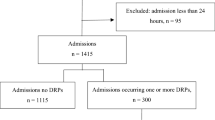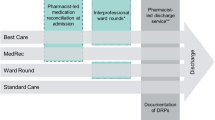Abstract
Background Drug-related problems (DRPs) are common in hospitalized patients with neurological diseases. Clinical pharmacy services could minimize drug-related harm and improve patient care. Objective To identify common DRPs in neurology and document clinical pharmacists’ medication-related interventions. Setting The wards and intensive care unit of the Department of Neurology at Assiut University Hospital. Method Prospective study of clinical pharmacists’ interventions during the routine care work of reviewing patients medical charts over a period of 6 months from January to June 2017. Main outcome measure The frequency and severity of DRPs and clinical pharmacists’ recommendations. Results Out of 1421 reviewed medications charts, a total of 414 DRPs were detected for 285 admitted patients. The most common DRPs were drug selection problems (36.7%) and dosing errors (27.5%). The majority of DRPs (71.7%) were categorized as causing no patient harm. Clinical pharmacists provided recommendations for the detected problems that ranged from drug monitoring to stop and starting new medicines. About 90% of pharmacists’ interventions were accepted by physicians. Poisson regression of factors that may influence the frequency of DRPs revealed significant associations of patient age (p = 0.03) and the number of comorbid diseases (p = 0.01). Conclusions Prescribing errors in neurology inpatient are likely to occur. Clinical pharmacists’ interventions assisted in early detection of drug problems and prevention of the consequent patient harms.


Similar content being viewed by others
References
World Health Organization. World alliance for patient safety. Geneva: WHO; 2005. http://www.who.int/patientsafety/en/brochure_final.pdf Accessed 9 Sept 2017.
Garfield S, Reynolds M, Dermont L, Franklin BD. Measuring the severity of prescribing errors: a systematic review. Drug Saf. 2013;36(12):1151–7.
Lewis PJ, Dornan T, Taylor D, Tully MP, Wass V, Ashcroft DM. Prevalence, incidence and nature of prescribing errors in hospital inpatients: a systematic review. Drug Saf. 2009;32(5):379–89.
Foroughinia F, Tazarehie SR, Petramfar P. Detecting and managing drug-related problems in the neurology ward of a tertiary care teaching hospital in Iran: a clinical pharmacist’s intervention. J Res Pharm Pract. 2016;5(4):285–9.
Taegtmeyer AB, Curkovic I, Corti N, Rosen C, Egbring M, Russmann S, et al. Drug-related problems and factors influencing acceptance of clinical pharmacologists alerts in a large cohort of neurology inpatients. Swiss Med Wkly. 2012;142:w13615.
Lenssen R, Heidenreich A, Schulz JB, Trautwein C, Fitzner C, Jaehde U, et al. Analysis of drug-related problems in three departments of a German University hospital. Int J Clin Pharm. 2016;38(1):119–26.
Kaboli PJ, Hoth AB, McClimon BJ, Schnipper JL. Clinical pharmacists and inpatient medical care: a systematic review. Arch Intern Med. 2006;166(9):955–64.
Bladh L, Ottosson E, Karlsson J, Klintberg L, Wallerstedt SM. Effects of a clinical pharmacist service on health-related quality of life and prescribing of drugs: a randomised controlled trial. BMJ Qual Saf. 2011;20(9):738–46.
Weant KA, Armitstead JA, Ladha AM, Sasaki-Adams D, Hadar EJ, and Ewend MG. Cost effectiveness of a clinical pharmacist on a neurosurgical team. Neurosurgery. 2009;65(5):946–50 (discussion 950-1).
Yi ZM, Sun SS, Li XX, Lu M, Zhai SD. An evaluation of clinical pharmacist service on a neurology care unit. Int J Clin Pharm. 2016;38(1):30–3.
Bourne RS, Dorward BJ. Clinical pharmacist interventions on a UK neurosurgical critical care unit: a 2-week service evaluation. Int J Clin Pharm. 2011;33(5):755–8.
Rubinos C, Ruland S. Neurologic complications in the intensive care unit. Curr Neurol Neurosci Rep. 2016;16(6):57.
Pharmaceutical Care Network Europe drug-related problem classification (PCNE-DRP). 2017 June 2017. http://www.pcne.org/upload/files/11_PCNE_classification_V6-2.pdf. Accessed Jan 2017.
Lexicomp—clinical drug information. https://online.lexi.com/lco/action/login. Accessed 20 Feb 2017.
Armahizer MJ, Kane-Gill SL, Smithburger PL, Anthes AM, Seybert AL. Comparing drug–drug interaction severity ratings between bedside clinicians and proprietary databases. ISRN Crit Care. 2013;2013:6.
Seden K, Kirkham JJ, Kennedy T, Lloyd M, James S, Mcmanus A, et al. Cross-sectional study of prescribing errors in patients admitted to nine hospitals across North West England. BMJ Open. 2013;3(1):e002036.
European Stroke Organization (ESO) guidelines. https://eso-stroke.org/eso-guideline-directory/. Accessed 02 Jan 2017.
National Institute for Health and Clinical excellence: guidance. In: The epilepsies: the diagnosis and management of the epilepsies in adults and children in primary and secondary care: pharmacological update of clinical guideline 20. London: Royal College of Physicians (UK), National Clinical Guideline Centre; 2012. p. 1–99
The national coordinating council for medication error reporting and prevention (NCC MERP) index. 2001 June 2017. http://www.nccmerp.org/types-medication-errors. Accessed Jan 2017.
Dornan T, Ashcroft D, Heathfield H, Lewis P, Miles J, Taylor D, et al. An in depth investigation into causes of prescribing errors by foundation trainees in relation to their medical education. EQUIP Study. London: General Medical Council; 2009.
Ansari JA. Drug interaction and pharmacist. J Young Pharm JYP. 2010;2(3):326–31.
Acknowledgements
Assistance of pharmacists, Asmaa Alhosainy and Eman Mostafa in data collection and documentation of drug-related problems for this study, is gratefully acknowledged.
Author information
Authors and Affiliations
Corresponding author
Ethics declarations
Funding
This research received no specific grant from any funding agency in the public, commercial or not-for-profit sectors.
Conflicts of interest
The authors declare no conflict of interest.
Rights and permissions
About this article
Cite this article
Ali, M.A.S., Khedr, E.M.H., Ahmed, F.A.H. et al. Clinical pharmacist interventions in managing drug-related problems in hospitalized patients with neurological diseases. Int J Clin Pharm 40, 1257–1264 (2018). https://doi.org/10.1007/s11096-018-0658-0
Received:
Accepted:
Published:
Issue Date:
DOI: https://doi.org/10.1007/s11096-018-0658-0




